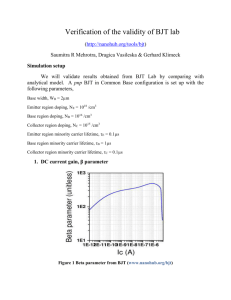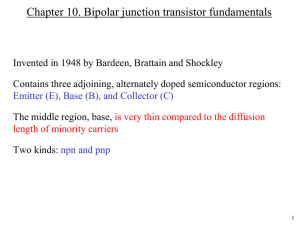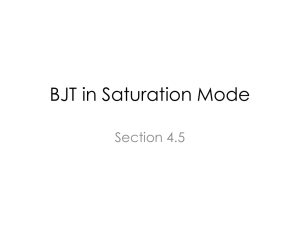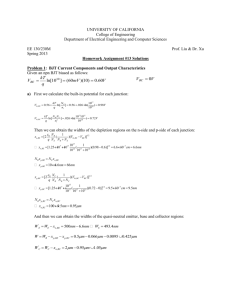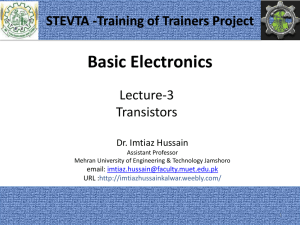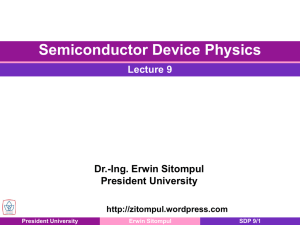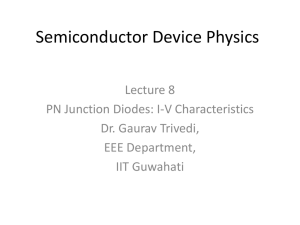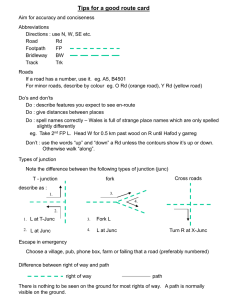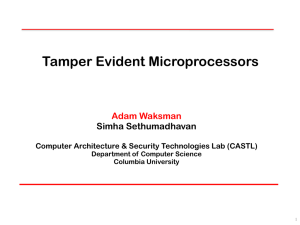Document
advertisement
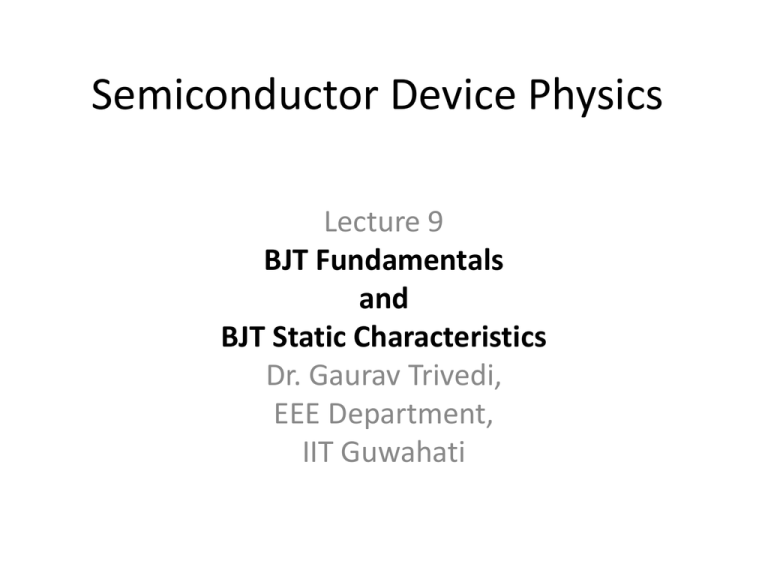
Semiconductor Device Physics Lecture 9 BJT Fundamentals and BJT Static Characteristics Dr. Gaurav Trivedi, EEE Department, IIT Guwahati Bipolar Junction Transistors (BJTs) Over the past decades, the higher layout density and low-power advantage of CMOS (Complementary Metal–Oxide–Semiconductor) has eroded away the BJT’s dominance in integrated-circuit products. Higher circuit density better system performance BJTs are still preferred in some digital-circuit and analog-circuit applications because of their high speed and superior gain Faster circuit speed (+) Larger power dissipation (–) • Transistor: current flowing between two terminals is controlled by a third terminal Introduction Circuit Configurations Modes of Operation Common-Emitter Output Characteristics Mode E-B Junction C-B Junction Saturation forward bias forward bias Active/Forward forward bias reverse bias Inverted reverse bias forward bias Cutoff reverse bias reverse bias BJT Electrostatics Under equilibrium and normal operating conditions, the BJT may be viewed electrostatically as two independent pn junctions. NAE NDB NAC WCB WEB W WB xnEB xnCB W : quasineutral base width BJT Electrostatics Electrostatic potential, V(x) Electric field, E(x) Charge density, ρ(x) BJT Design Important features of a good transistor: Injected minority carriers do not recombine in the neutral base region short base, W << Lp for pnp transistor Emitter current is comprised almost entirely of carriers injected into the base rather than carriers injected into the emitter the emitter must be doped heavier than the base pnp BJT, active mode Base Current (Active Bias) The base current consists of majority carriers (electrons) supplied for: 1. Recombination of injected minority carriers in the base 2. Injection of carriers into the emitter 3. Reverse saturation current in collector junction 4. Recombination in the base-emitter depletion region EMITTER COLLECTOR BASE 1 iCB0 4 p-type 2 n-type 3 p-type BJT Performance Parameters (pnp) Collector Current (Active Bias) The collector current is comprised of: Holes injected from emitter, which do not recombine in the base 2 Reverse saturation current of collector junction 3 I C αdc I E ICB0 ICB0 :collector current when IE = 0 IC αdc ( IC I B ) ICB0 αdc I CB0 IC IB 1 αdc 1 αdc I C βdc I B ICE0 Common emitter dc current gain: dc IC dc 1 dc I B Notation (pnp BJT) Minority carrier constants N E N AE DE DN E n LE LN nE0 np0 ni2 N E N B N DB DB DP B p LB LP pB0 pn0 ni2 N B N C N AC DC DN C n LC LN nC0 np0 ni2 N C Emitter Region Diffusion equation: d 2 nE nE 0 DE 2 dx E Boundary conditions: nE ( x ) 0 nE ( x 0) nE0 (eqVEB kT 1) Base Region Diffusion equation: d 2 pB pB 0 DB 2 dx B Boundary conditions: pB (0) pB0 (eqVEB kT 1) pB (W ) pB0 (eqVCB kT 1) Collector Region Diffusion equation: d 2 nC nC 0 DC 2 dx C Boundary conditions: nC ( x ' ) 0 nC ( x ' 0) nC0 (eqVCB kT 1) Ideal Transistor Analysis Solve the minority-carrier diffusion equation in each quasi-neutral region to obtain excess minority-carrier profiles Each region has different set of boundary conditions nE ( x), Evaluate minority-carrier diffusion currents at edges of depletion regions p ( x), B nC ( x) I En I Cn d nE qADE dx x0 d nC qADC dx x0 I Ep I Cp d pB qADB dx d pB qADB dx x 0 x W Add hole and electron components together terminal currents is obtained IC IE IB I E I Ep I En I C I Cp I Cn IB IE IC Emitter Region Solution Diffusion equation: General solution: Boundary conditions: d 2 nE nE 0 DE 2 dx E x LE x LE nE ( x ) Ae A2e 1 nE ( x ) 0 nE ( x 0) nE0 (eqVEB kT 1) nE ( x) nE0 (eqVEB kT 1)e x LE Solution I En d nE qADE dx DE qA nE0 (eqVEB LE x0 kT 1) Collector Region Solution Diffusion equation: General solution: Boundary conditions: d 2 nC nC 0 DC 2 dx C x LC x LC nC ( x ) Ae A2e 1 nC ( x ) 0 nC ( x 0) nC0 (eqVCB kT 1) nC ( x) nC0 (eqVCB Solution I Cn kT 1)ex LC DC d nC qA nC0 (eqVCB qADC LC dx x0 kT 1) Base Region Solution d 2 nB pB 0 DB 2 dx B Diffusion equation: General solution: x LB x LB pB ( x) Ae A e 1 2 Boundary conditions: pB (0) pB0 (eqVEB kT 1) pB (W ) pB0 (eqVCB kT 1) Solution (W x ) LB (W x ) LB e e qVEB kT pB ( x) pB0 (e 1) W LB W LB e e x LB x LB e e qVCB kT pB0 (e 1) W LB W LB e e Base Region Solution Since e e sinh( ) 2 (W x ) LB (W x ) LB e e qVEB kT pB ( x) pB0 (e 1) W LB W LB e e x LB x LB e e qVCB kT pB0 (e 1) W LB W LB e e We can write as pB ( x) pB0 (e qVEB kT pB0 (eqVCB 1) kT sinh (W x) LB sinh(W LB ) sinh( x LB ) 1) sinh(W LB ) Base Region Solution Since I Ep I Cp d d e e sinh( ) d d 2 e e cosh( ) 2 d pB qADB dx x 0 cosh(W LB ) qVEB DB qA pB0 (e LB sinh(W LB ) d pB qADB dx x W DB 1 qA pB0 (eqVEB LB sinh(W LB ) kT kT 1 1) (eqVCB sinh(W LB ) cosh(W LB ) qVCB 1) (e sinh(W LB ) kT kT 1) 1) Terminal Currents Since Then I E I En I Ep , IC ICn ICp DE DB cosh(W LB ) qVEB I E qA nE0 pB0 (e LB sinh(W LB ) LE DB qVCB kT 1 pB0 1) (e sinh(W LB ) LB D qVEB kT 1 B I C qA p (e 1) L B0 sinh W L B B DC DB cosh(W LB ) qVCB nC0 pB0 (e LB sinh(W LB ) LC I B I E IC kT kT 1) 1) Simplified Relationships To achieve high current gain, a typical BJT will be constructed so that W << LB. Using the limit value lim sinh( ) 0 lim cosh( ) 1 0 2 2 Due to VEB We will have x pB ( x) pB0 (e 1) 1 W x qVCB / kT pB0 (e 1) W qVEB / kT x pB ( x) pB (0) pB0 (W ) pB (0) W Due to VCB Performance Parameters For specific condition of “Active Mode”: emitter junction is forward biased and collector junction is reverse biased W << LB, nE0/pB0 NB/NE 1 DE N B W 1 DB N E LE dc T 1 DE N B W 1 W 1 DB N E LE 2 LB 2 , dc 1 1W 1 2 LB 2 1 DE N B W 1 W DB N E LE 2 LB 2 Ebers-Moll Model The Ebers-Moll model is a large-signal equivalent circuit which describes both the active and saturation regions of BJT operation. This model is to be used to calculate IC, IE for given VBE, VBC. D cosh W LB qVEB D I E qA E nE0 B pB0 (e L L sinh W L B E B qVCB kT 1 IFO DB pB0 ( e 1) L sinh W L B B kT 1) D qVEB kT 1 IRO I C qA B pB0 1) (e L sinh W L B B D cosh W LB qVCB kT D C nC0 B pB0 ( e 1) L L sinh W L B B C If only VEB is applied (VCB = 0): If only VCB is applied (VEB = 0): I E I F0 (eqVEB kT 1) I C F I F0 (eqVEB kT 1) I B (1 F ) I F0 (eqVEB kT 1) I C I R0 (eqVCB kT 1) I E R I R0 (eqVCB kT 1) I B I R0 (1 R )(eqVCB kT 1) Ebers-Moll Model Reciprocity relationship: F I F0 R I R0 pB0 DB qA LB sinh(W LB ) R : reverse common base gain F : forward common base gain In the general case, when VEB and VCB are non-zero: I C F I F0 (e qVEB kT 1) I R0 (e qVCB fraction of E-B diode current that makes it to the C-B junction I E I F0 (e qVEB kT E-B diode current kT 1) C-B diode current 1) R I R0 (e qVCB kT 1) fraction of C-B diode current that makes it to the E-B junction Deviations from the Ideal Common base Deviations, due to model limitations Common emitter Base-Width Modulation Common-Emitter Configuration Active Mode Operation Recalling two formulas, W IE P+ N IC P + VEB I C βdc I B ICE0 1 dc 2 DE N B W 1 W DB N E LE 2 LB D N L B E E DE N BW pB(x) qVEB kT pB0 (e 1) (VCB=0) Increasing – VCB x 0 W If –VCB increases → W decreases → dc increases → IC increases Punch-Through Punch-Through: E-B and C-B depletion regions in the base touch each other, so that W = 0. WB xnEB xnCB As –VCB increases beyond the punchthrough point, the E-B potential hill decreases and therefore increases the carrier injections and IC. Breakdown Mechanisms In the common-emitter configuration, for high output voltage VCE, the output current IC will increase rapidly due to the two mechanisms: punch-through and avalanche. Punch-through Avalanche VEC =VEB VCB Increasing reverse bias of C-B junction Avalanche Multiplication Holes [0] are injected into the base [1], then collected by the C-B junction. Some holes in the C-B depletion region have enough energy do impact ionization [2]. The generated electrons are swept into the base [3], then injected into the emitter [4]. Each injected electron results in the injection of IEp/IEn holes from the emitter into the base [5]. For each pair created in the C-B depletion region by impact ionization, (IEp/IEn) +1> dc additional holes flow into the collector. This means that carrier multiplication in C-B depletion region is internally amplified. pnp BJT Mαdc I CB0 IC IB 1 Mαdc 1 Mαdc M : multiplication factor Geometrical Effects Emitter area is not equal to collector area. Current does not flow in one direction only. Series resistance. Voltage drop occurs not only across the junction. Current crowding. Due to lateral flow, current is larger around emitter periphery than the collector periphery. Graded Base Dopants are injected through diffusion. More or less falling exponential distribution with distance into beneath of the semiconductor. The doping within the base is not constant as assumed in ideal analysis. A function of position, having maximum at E-B junction and minimum at C-B junction. Creating a built-in electric field. The electric field enhances the transport of minority carrier across the quasineutral width of the base. Increase of IE and IC. kT q E xdiff xdiff : exponential decay constant Figures of Merit Due to recombination in emitter depletion region Gummel Plot Due to high level injection in base, base series resistance, and current crowding Polysilicon Emitter BJT dc is larger for a poly-Si emitter BJT as compared with an all-crystalline emitter BJT. This is due to reduced dpE(x)/dx at the edge of the emitter depletion region. Lower p Continuity of hole current in emitter d pE1 d pE2 qDE1 qDE2 dx dx d pE1 DE2 d pE2 E2 d pE2 dx DE1 dx E1 dx (1 polysilicon; 2 Si) Shallower slope less JP higher , Summary on BJT Performance High gain (dc >> 1) One-sided emitter junction, so that emitter efficiency 1 Emitter doped much more heavily than base (NE >> NB). Narrow base, so base transport factor T 1. Quasi-neutral base width << minority-carrier diffusion length (W << LB). IC determined only by IB (IC function of VCE or VCB) One-sided collector junction, so that quasineutral base width W does not change drastically with changes in VCE or VCB. Base doped more heavily than collector (NB > NC), W = WB – xnEB – xnCB for pnp BJT.
